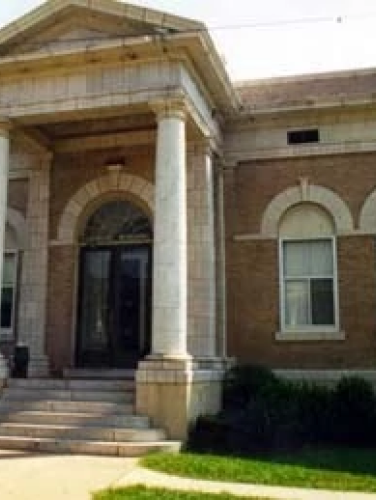
Carnegie Library Building
(ca. 1912)
The Carnegie Library building, home of the Johnson C. Smith University library collection for nearly seventy years, remains a vital campus asset.
100 Beatties Ford Rd, Charlotte, NC 28216
The Carnegie Library building at Johnson C. Smith University is one of Mecklenburg County’s oldest and finest examples of Neoclassical architecture. For more than a century, the building has been a campus landmark, first as the school’s primary library from 1912 to 1978 and now as a significant contributor to other aspects of the university’s academic endeavors.
Property Quick Links
Started in 1867, Biddle Memorial Institute was a post-Civil War theology school established under the Committee on Freedmen of the Presbyterian Church, USA, to train the formerly enslaved to become ministers and teachers throughout the South. Started with eight or ten students in a church at Fourth and Davidson Streets, the school migrated to its current campus in 1870, the same year that Reverend Dr. Stephen Mattoon (1815-1886) was elected the school’s first president.
By 1904, during the tenure of Biddle’s first Black president, Reverend Daniel J. Sanders (served 1891-1907), the need for a new library became clear. Dr. Sanders wrote to philanthropist Andrew Carnegie requesting a gift for that purpose. The Pittsburgh tycoon, whose Carnegie Steel Company formed the basis for U.S. Steel, responded that he would provide $12,500 for a new library if the school could raise an equal amount for an endowment to maintain it. Dr. Sanders died in 1907 before the challenge could be met. His successor, Dr. Henry L. McCrorey – who guided the institution for the next forty years into becoming one of the leading Black colleges in the nation – made completion of the fundraising for the new library one of his first priorities. Within three years, the money had been raised. The architectural firm of Hunter and Gordon was commissioned to design the new campus building. Leonard LeGrand Hunter (1881-1925), a Huntersville native, and Frank Gordon (1870-1930) of Maine both moved to Charlotte around 1905. They formed their partnership in about 1909 and earned such notable commissions as Charlotte’s Mercy Hospital, the E. C. Marshall mansion in Myers Park, and the Chalmers A.R.P. Church on South Boulevard.
The cornerstone for the Carnegie Library was laid on November 15, 1911, and the building was completed in time for its dedication at the school’s forty-fourth commencement in 1912. By that fall, the library was open and ready for use. It featured a lecture room, a reading room, a board room, and a stack room with a capacity of 5,000 volumes in wall stacks and an additional 11,000 volume capacity in floor stacks that could be constructed when needed. At the time of its opening, the library already boasted a collection of 8,000 volumes. The library struggled because of a lack of professional staff until 1930, when the administration hired alumnus Theodus L. Gunn as its first full-time, trained librarian.

